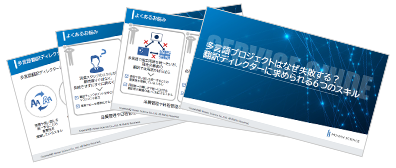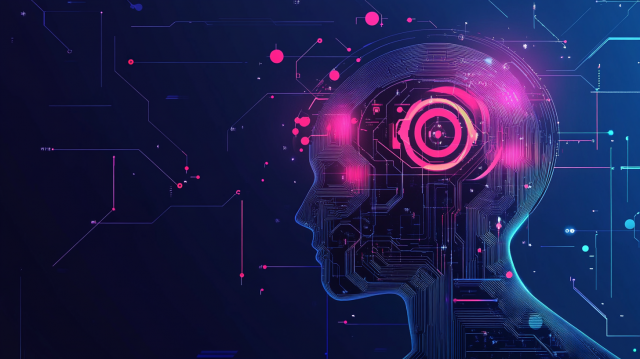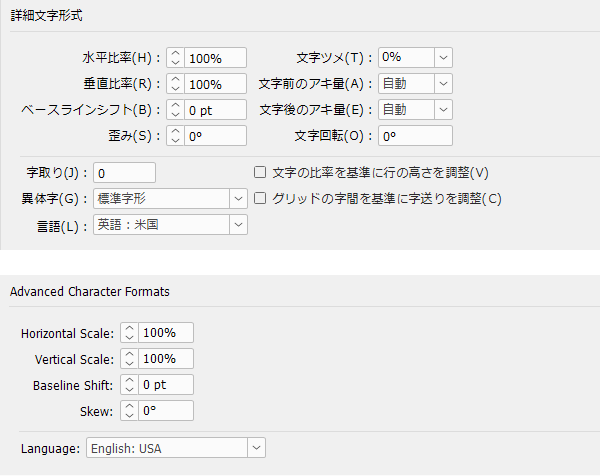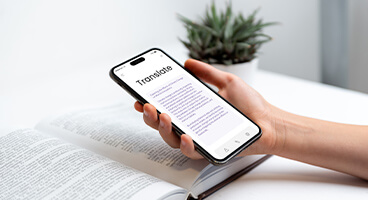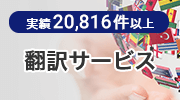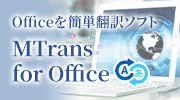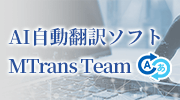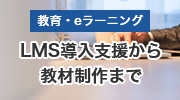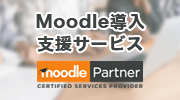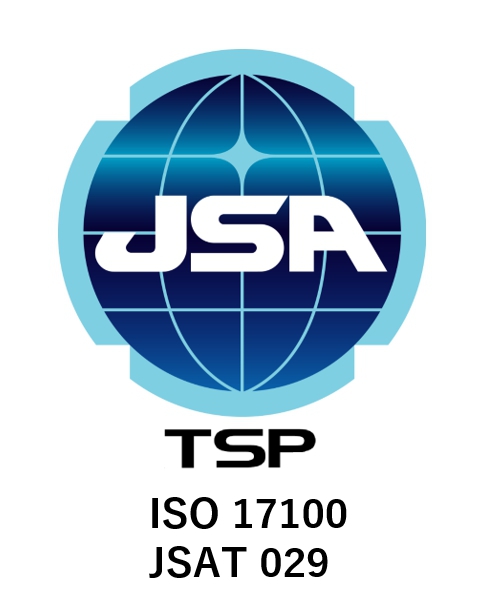
Recently, the demand for translation not only from Japanese to English but also into many other languages has been increasing, and we have been receiving inquiries at our company as well. Many people are considering translation into multiple languages, not just Japanese to English (or English to Japanese), in other words, "multilingual translation." On the other hand, some people may have a vague impression of multilingual translation. Therefore, this time, we will explain multilingual translation in detail.
For those who need translation into multiple languages but are unsure how it differs from Japanese↔English translation, we hope this blog will help you get a clearer picture.
- Table of Contents
-
- 1. What is Multilingual Translation? Basic Concepts and Application Areas
- 1-2. MDR Requiring Multiple Languages
- 2. Methods of Multilingual Translation and Their Advantages and Disadvantages
- 2-1. Differences Between Human Translation and Machine Translation: A Quality Comparison
- 2-2. Differences Between Human Translation and Machine Translation: A Comparison of Time and Cost
- 2-3. The Option of Post-Editing
- 3. Utilization of LLM (Generative AI) Proofreading Tools in Multilingual Translation
- 4. Points for Choosing a Multilingual Translation Provider
- 4-1. Track Record and Expertise
- 4-2. ISO in Translation Services: ISO17100, ISO18587
- 4-3. Project Management System
- 5. How to Request Multilingual Translation
- 6. Case Studies of Multilingual Translation
- 6-1. Introduction of Case Studies
- 6-2. Summary of the Effects of Implementing Multilingual Translation
- 7. Summary
1. What is Multilingual Translation? Basic Concepts and Application Areas
Multilingual translation refers to translating text or audio from one language into multiple languages. For example, translating from Japanese into three languages such as English, Chinese, and Korean is considered multilingual translation.
As society becomes more globalized, multilingual translation plays an important role in various fields such as international business, tourism, education, and healthcare. We receive many inquiries at our company as well, and recently, we have especially noticed an increase in requests for multilingual translation in the area of "MDR".
Now, are you familiar with "MDR"? Depending on the field you usually work in, some people may know it well, some may have heard of it, and others may not know it at all. The next paragraph will briefly explain what "MDR" is.
1-2. MDR Requiring Multiple Languages
MDR stands for Medical Device Regulation. This regulation was established by the European Union (EU) to ensure the safety and effectiveness of medical devices circulated in the EU market. MDR replaces the previous Medical Device Directive (MDD) and has been in effect since May 26, 2020. The new MDR regulation stipulates the following points.
・To ensure the safety and effectiveness of medical devices, translate documents such as technical files, instructions for use, and labels into the official languages of each EU member state
・To enhance the transparency of medical devices, provide information on product safety and clinical performance in multiple languages
In other words, to comply with MDR, it is necessary to accurately translate all related documents into each language.
The increase in requests and inquiries for multilingual translation, in other words, the growing need for multilingual translation, is partly due to the background of such MDR regulations.
>>Related BlogSmooth Multilingual Deployment! 5 Key Points for English Translation in Manufacturing and IT
2. Methods of Multilingual Translation and Their Advantages and Disadvantages
Now, from here, we will introduce points related to actual multilingual translation.
First, there are two main types of translation methods: "human translation," where a translator translates from scratch, and "machine translation," which utilizes machine-based translation.
Our company appropriately switches between these methods according to customer requests, and the same applies to multilingual translation.
Here, we will briefly explain the differences between "human translation" and "machine translation," including perspectives unique to multilingual translation.
2-1. Differences Between Human Translation and Machine Translation: A Quality Comparison
Translation Quality
<Human Translation>
・Translation that takes into account the surrounding context is possible
・It is possible to add paraphrasing and supplementary explanations as needed to make it easier to understand
<Machine Translation>
・Often outputs text that does not require any editing
・Difficult to produce translations that accurately capture context
・Cannot add information beyond the original text or paraphrase
Machine translation has made great strides thanks to advances in AI, but it is still difficult to accurately judge context. While it often produces relatively accurate output for text that does not depend on context, when the content relies on context, it can generate sentences that are incomprehensible or contain critical mistranslations.
On the other hand, human translators translate with an understanding of the surrounding context. Therefore, they can appropriately paraphrase and, when necessary, add supplementary explanations as part of their translation.
2-2. Differences Between Human Translation and Machine Translation: A Comparison of Time and Cost
Time and Cost
<Human Translation>
・Takes more time and cost than machine translation
・The number of translators is limited
<Machine Translation>
・If only output is required, it can be completed in a very short time
・As long as the engine supports it, output can be generated immediately even for minor languages
Although it varies by project, for Japanese-English translation, a single translator can translate about 4,000 characters per day, and for multilingual translation with English as the source text, about 2,000 words is used as a standard. On the other hand, in the case of machine translation, output alone can be completed in just a few minutes.
Also, a unique point of multilingual translation is that for languages not very familiar in Japan, there are few translators available. It can take time to arrange translators, and there may be inflexibility in terms of cost and schedule. In the case of machine translation, as long as the engine supports it, output is possible.
The multilingual translation associated with the MDR introduced earlier often requires real-time and rapid response, so the ability to respond within a short period is a very important point.
2-3. The Option of Post-Editing
Now, it has become clear that human translation has an advantage in terms of quality, while machine translation is advantageous in terms of time and cost. Of course, both points are important, so the reality is that it is difficult to completely discard either one.
Therefore, as a method to approach the quality of human translation while also leveraging the time and cost benefits of machine translation, our company often performs "post-editing" following "machine translation."
This flow involves first translating the entire text with machine translation, then having a translator (post-editor) revise it. By doing so, it is possible to prepare a translation that has been polished in quality from machine translation in a shorter period compared to human translation.
This is an important approach especially for translations related to MDR, where there is limited time but mistranslations or overly unnatural translations are unacceptable.
3. Utilization of LLM (Generative AI) Proofreading Tools in Multilingual Translation
The need to balance quality and shorter turnaround times is not limited to MDR.
Our company is exploring ways to achieve this balance using various tools and the latest technologies.
Here, we will introduce one of these methods.
Our company is developing a proofreading tool that incorporates an LLM (Large Language Model). An LLM is a generative AI trained on a large amount of text data. By inputting translated texts into this tool, the goal is to automatically detect errors and provide translations quickly and accurately.
As part of this initiative, our company is also conducting verification using multilingual translation results; however, to be honest, it is still at a stage where practical application is difficult. Nevertheless, we believe that by continuing to update and examining operational methods in the future, there is potential for effective utilization.
Now, let us briefly introduce a verification case conducted by our company.
<Verification Method>
For the translations immediately after machine translation, we prepared two patterns in a total of seven languages: French, Italian, German, Spanish, Portuguese, Dutch, and Russian.
・Human proofreading (regular proofreading)
・Proofreading results by the LLM proofreading tool
We compared these two and conducted verification from five check perspectives: "mistranslation/omission," "grammar errors," "unnatural expressions," "inappropriate expressions," and "format errors."
<Verification Results>
There are differences depending on the language, but generally the following points were common.
1) High detection rate and accuracy
“Mistranslations and omissions” and “Grammar errors”
Although some of the flagged issues did not require correction, the number of actual problematic errors (those needing correction) was not significantly different from the number of errors pointed out by the proofreaders, indicating a high detection rate of errors from this perspective.
2) Low detection rate and accuracy
"Unnatural expressions," "inappropriate expressions," and "format errors"
There were many unnecessary correction suggestions for "unnatural expressions" and "inappropriate expressions," while the number of "format errors" detected was fewer than those pointed out by proofreaders, indicating that both the detection rate and accuracy of errors were low.
LLMs (generative AI) are advancing daily, and their accuracy is expected to improve even further in the future. Although it is still difficult to utilize them practically at present, we believe there is a strong possibility that they will become practical for multilingual translation in the future.
4. Points for Choosing a Multilingual Translation Provider
So far, we have explained the multilingual translation process and our company's efforts and initiatives. Here, we will explain important points to consider when choosing a service provider for multilingual translation, that is, the translator.
4-1. Track Record and Expertise
When considering whom to request a translation from, the most important factors are experience and expertise.
Not everyone who has studied a language can perform translations. Accurate and natural translations require experience.
Additionally, translations in specific fields (such as medical, legal, or technical) often involve many specialized terms. Even if someone has decades of translation experience in that language, they cannot translate accurately without detailed knowledge of the specialized field.
This is not limited to multilingual translation but applies to all types of translation; however, we recommend first narrowing down your inquiries to companies with extensive experience in the target language and field.
4-2. ISO in Translation Services: ISO17100, ISO18587
ISO stands for the International Organization for Standardization, a non-governmental organization that provides global standard specifications across various fields. Obtaining ISO certification proves that a company meets the international standards set by ISO.
ISO17100
There is also a standard called ISO17100 for translation services. ISO17100 defines various requirements for the translation process from the start of translation to delivery, and it also sets regulations regarding the qualifications and competencies of translators and proofreaders.
Our company has obtained this ISO17100 certification, including for multilingual services.
ISO18587
ISO18587 is an international standard issued in 2017, which specifies requirements for post-editing using machine translation. Only a few translation companies in Japan have obtained this certification.
Our company has obtained both ISO17100 and ISO18587 certifications.
For more details, please see the article below.
>>What is the international standard ISO18587? Necessary preparations and key points for certification acquisition | Blog | Human Science Co., Ltd.
4-3. Project Management System
Multiple people are involved in translation projects. To properly carry out translation projects with multiple members, our company creates a control plan for each project and proceeds with progress and management according to it.
This control plan reflects the regulations stipulated in ISO17100, and we conduct progress/management in accordance with the standard.
5. How to Request Multilingual Translation
Next, we will introduce how to request multilingual translation when it is actually needed.
Below are the key points and preparations you should make when requesting multilingual translation.
Target Language Variant
For example, in the case of Portuguese, there are two types: European Portuguese (Portugal) and Brazilian Portuguese. Spanish also differs linguistically between Spain-targeted and Mexico-targeted versions. In this way, be sure to confirm the target country and clearly communicate it to the service provider.
Source Text
In the case of multilingual translation, it is common to translate from English to multiple languages, and if the original text is only in Japanese, it is highly likely that it will first need to be translated into English and then from English into multiple languages.
This is due to the difference in the number of translators available. For example, there are far more translators who can translate from English to Spanish than those who can translate from Japanese to Spanish, making it easier to secure translators. Additionally, selecting an appropriate translator from a large pool increases the likelihood of finding one who is well-matched to the specific field. For these reasons, many multilingual translations are conducted with English as the source text.
However, it is not always the case that multilingual translations must be done from English, so it is best to first contact a translation company.
Reference Materials
Reference materials necessary for translation include style guides, glossaries, and TMs (Translation Memory).
A style guide defines the style for each language, a glossary provides standardized term translations, and a TM is a repository of past translation assets. Having these materials offers various benefits, such as ensuring consistency in the translated text and reducing translation costs. If you have reference materials, please provide them to the translation provider.
For translations related to revisions of manuals, the previous edition of the multilingual manual also serves as a reference material, so it is recommended to provide the previous edition manual as well.
6. Case Studies of Multilingual Translation
This is not limited to multilingual translation, but there are differences in cost and delivery time between human translation and machine translation, and the respective advantages and disadvantages have been described above.
Recently, we have received many inquiries about machine translation, so here we introduce an example of a client who implemented machine translation in multilingual translation. By introducing machine translation, they were able to achieve cost reduction and shorter delivery times.
6-1. Introduction of Case Studies
We will introduce examples of multilingual translation projects conducted by our company.
・Medical Device Manufacturer
Subject: Medical device instruction manuals
Languages: English → 5 languages (French, Italian, German, Spanish, Brazilian Portuguese)
Volume: Small quantity
Frequency: Several times a month
<Background>
This client was considering the introduction of machine translation to reduce translation costs and turnaround times. Our company supported the implementation of machine translation, and we are currently providing multilingual translation services using machine translation.
As preparation for introducing machine translation, we conducted a quality evaluation using the actual translation data to be used and selected the most suitable machine translation engine for this translation data. In response to the client’s request of "We want to introduce machine translation but do not want to lower translation quality," we proposed adding a reviewer step by a translator in addition to the standard machine translation process of "machine translation + post-editing." As a result, we were able to achieve quality comparable to conventional human translation even with machine translation.
The client has also evaluated that there are "no quality issues" in all languages. Regarding the challenges of cost reduction and shorter turnaround times, which were the objectives of introducing machine translation, we achieved a 20% cost reduction and shorter delivery times, successfully overcoming these challenges.
6-2. Summary of the Effects of Implementing Multilingual Translation
– Cost: Approximately 20% reduction
– Delivery time: Shortened compared to before
– Quality: Evaluated as equivalent to human translation
– Customer evaluation: "No quality issues"
7. Summary
Human Science's translation services handle not only large volumes of translation but also cost reduction through the use of machine translation, as well as translations that reflect local laws and standards.
If you have concerns about quality, deadlines, or costs, please feel free to contact us first.


